书信开头结尾常用表达方式
- 格式:doc
- 大小:30.00 KB
- 文档页数:2
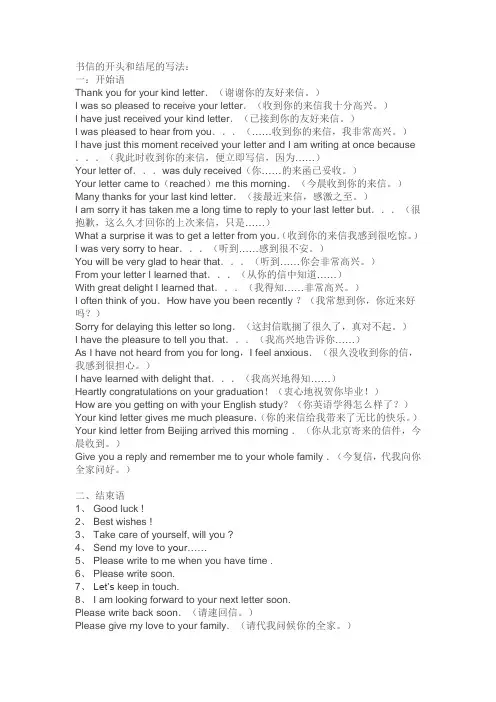
书信的开头和结尾的写法:一:开始语Thank you for your kind letter.(谢谢你的友好来信。
)I was so pleased to receive your letter.(收到你的来信我十分高兴。
)I have just received your kind letter.(已接到你的友好来信。
)I was pleased to hear from you...(……收到你的来信,我非常高兴。
)I have just this moment received your letter and I am writing at once because ...(我此时收到你的来信,便立即写信,因为……)Your letter of...was duly received(你……的来函已妥收。
)Your letter came to(reached)me this morning.(今晨收到你的来信。
)Many thanks for your last kind letter.(接最近来信,感激之至。
)I am sorry it has taken me a long time to reply to your last letter but...(很抱歉,这么久才回你的上次来信,只是……)What a surprise it was to get a letter from you.(收到你的来信我感到很吃惊。
)I was very sorry to hear...(听到……感到很不安。
)You will be very glad to hear that...(听到……你会非常高兴。
)From your letter I learned that...(从你的信中知道……)With great delight I learned that...(我得知……非常高兴。
)I often think of you.How have you been recently ?(我常想到你,你近来好吗?)Sorry for delaying this letter so long.(这封信耽搁了很久了,真对不起。
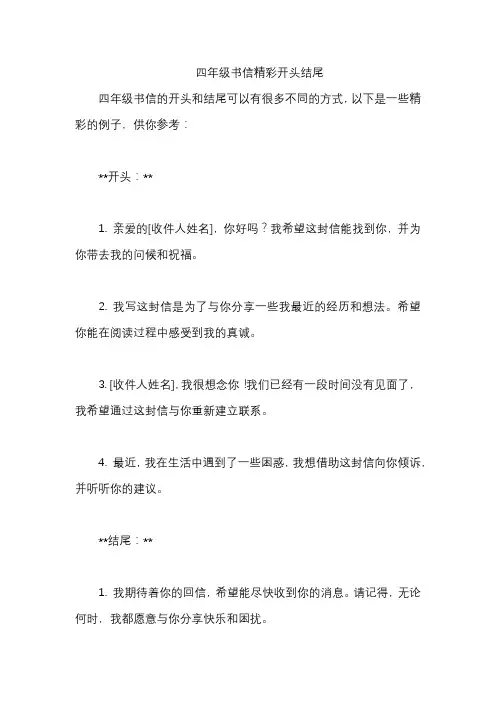
四年级书信精彩开头结尾
四年级书信的开头和结尾可以有很多不同的方式,以下是一些精彩的例子,供你参考:
**开头:**
1. 亲爱的[收件人姓名],你好吗?我希望这封信能找到你,并为你带去我的问候和祝福。
2. 我写这封信是为了与你分享一些我最近的经历和想法。
希望你能在阅读过程中感受到我的真诚。
3. [收件人姓名],我很想念你!我们已经有一段时间没有见面了,我希望通过这封信与你重新建立联系。
4. 最近,我在生活中遇到了一些困惑,我想借助这封信向你倾诉,并听听你的建议。
**结尾:**
1. 我期待着你的回信,希望能尽快收到你的消息。
请记得,无论何时,我都愿意与你分享快乐和困扰。
2. 最后,我想再次表达我对你的感激之情。
感谢你一直以来的支持和陪伴,希望我们的友谊长存。
3. 希望我的信没有让你感到太过冗长。
如果你有任何想和我分享的事情,也请随时写信给我。
4. 愿你生活中的每一天都充满阳光和快乐!请保持微笑,因为你的笑容是我最喜欢的。
这些开头和结尾只是一些例子,你可以根据自己的写信对象和内容进行适当的调整和修改。
最重要的是,要真诚地表达自己的情感和想法,让对方感受到你的真心。
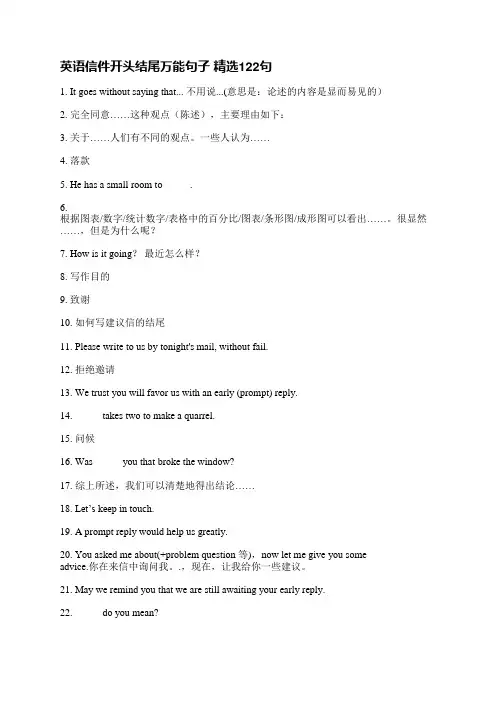
英语信件开头结尾万能句子精选122句1. It goes without saying that... 不用说...(意思是:论述的内容是显而易见的)2. 完全同意……这种观点(陈述),主要理由如下:3. 关于……人们有不同的观点。
一些人认为……4. 落款5. He has a small room to _____.6.根据图表/数字/统计数字/表格中的百分比/图表/条形图/成形图可以看出……。
很显然……,但是为什么呢?7. How is it going?最近怎么样?8. 写作目的9. 致谢10. 如何写建议信的结尾11. Please write to us by tonight's mail, without fail.12. 拒绝邀请13. We trust you will favor us with an early (prompt) reply.14. _____ takes two to make a quarrel.15. 问候16. Was _____ you that broke the window?17. 综上所述,我们可以清楚地得出结论……18. Let’s keep in touch.19. A prompt reply would help us greatly.20. You asked me about(+problem question 等),now let me give you someadvice.你在来信中询问我。
.,现在,让我给你一些建议。
21. May we remind you that we are still awaiting your early reply.22. _____ do you mean?23.在总体上很难说……是好还是坏,因为它在很大程度上取决于……的形势。
然而,就我个人而言,我发现……。
24.现在,……,它们给我们的日常生活带来了许多危害。
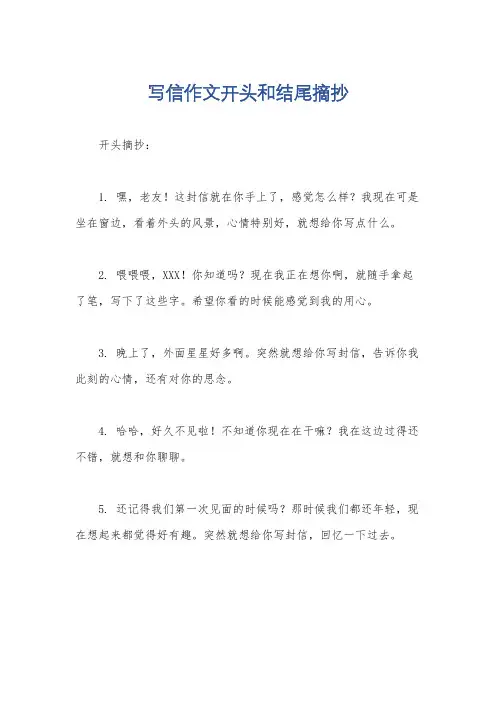
写信作文开头和结尾摘抄
开头摘抄:
1. 嘿,老友!这封信就在你手上了,感觉怎么样?我现在可是坐在窗边,看着外头的风景,心情特别好,就想给你写点什么。
2. 喂喂喂,XXX!你知道吗?现在我正在想你啊,就随手拿起了笔,写下了这些字。
希望你看的时候能感觉到我的用心。
3. 晚上了,外面星星好多啊。
突然就想给你写封信,告诉你我此刻的心情,还有对你的思念。
4. 哈哈,好久不见啦!不知道你现在在干嘛?我在这边过得还不错,就想和你聊聊。
5. 还记得我们第一次见面的时候吗?那时候我们都还年轻,现在想起来都觉得好有趣。
突然就想给你写封信,回忆一下过去。
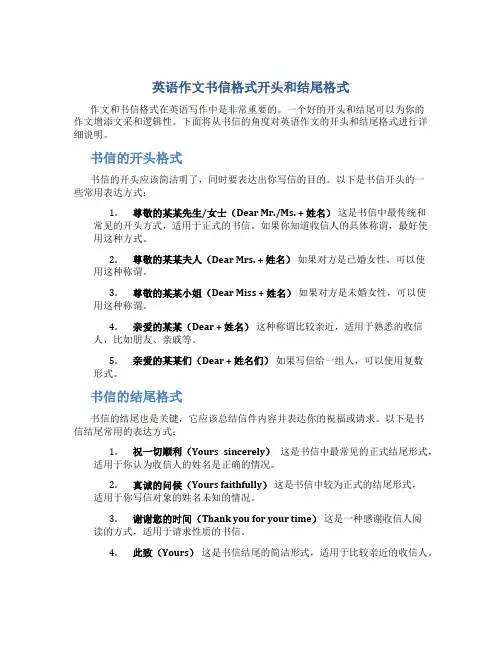
英语作文书信格式开头和结尾格式作文和书信格式在英语写作中是非常重要的。
一个好的开头和结尾可以为你的作文增添文采和逻辑性。
下面将从书信的角度对英语作文的开头和结尾格式进行详细说明。
书信的开头格式书信的开头应该简洁明了,同时要表达出你写信的目的。
以下是书信开头的一些常用表达方式:1.尊敬的某某先生/女士(Dear Mr./Ms. + 姓名)这是书信中最传统和常见的开头方式,适用于正式的书信。
如果你知道收信人的具体称谓,最好使用这种方式。
2.尊敬的某某夫人(Dear Mrs. + 姓名)如果对方是已婚女性,可以使用这种称谓。
3.尊敬的某某小姐(Dear Miss + 姓名)如果对方是未婚女性,可以使用这种称谓。
4.亲爱的某某(Dear + 姓名)这种称谓比较亲近,适用于熟悉的收信人,比如朋友、亲戚等。
5.亲爱的某某们(Dear + 姓名们)如果写信给一组人,可以使用复数形式。
书信的结尾格式书信的结尾也是关键,它应该总结信件内容并表达你的祝福或请求。
以下是书信结尾常用的表达方式:1.祝一切顺利(Yours sincerely)这是书信中最常见的正式结尾形式,适用于你认为收信人的姓名是正确的情况。
2.真诚的问候(Yours faithfully)这是书信中较为正式的结尾形式,适用于你写信对象的姓名未知的情况。
3.谢谢您的时间(Thank you for your time)这是一种感谢收信人阅读的方式,适用于请求性质的书信。
4.此致(Yours)这是书信结尾的简洁形式,适用于比较亲近的收信人。
5.希望尽快回复(Looking forward to your reply)这是一种期待对方回复的方式,适用于需要对方回复的书信。
书信的格式虽然简单,但其中的细节却可以展现出你的文采和修养。
合适的开头和结尾可以使你的信件更具说服力,希望以上内容对你有所帮助。
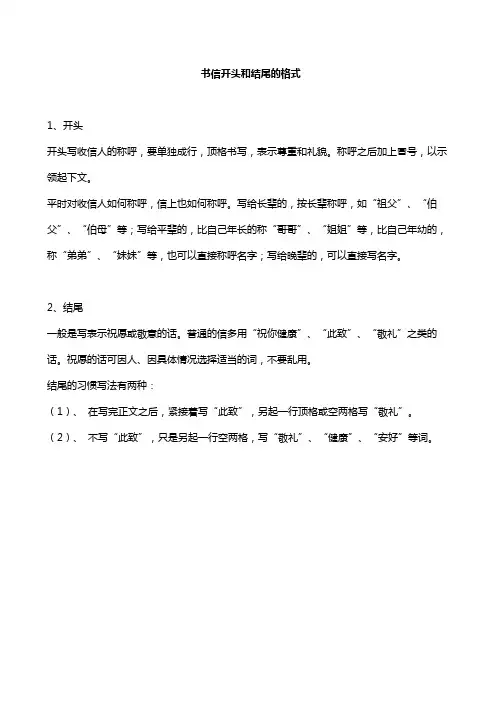
书信开头和结尾的格式
1、开头
开头写收信人的称呼,要单独成行,顶格书写,表示尊重和礼貌。
称呼之后加上冒号,以示领起下文。
平时对收信人如何称呼,信上也如何称呼。
写给长辈的,按长辈称呼,如“祖父”、“伯父”、“伯母”等;写给平辈的,比自己年长的称“哥哥”、“姐姐”等,比自己年幼的,称“弟弟”、“妹妹”等,也可以直接称呼名字;写给晚辈的,可以直接写名字。
2、结尾
一般是写表示祝愿或敬意的话。
普通的信多用“祝你健康”、“此致”、“敬礼”之类的话。
祝愿的话可因人、因具体情况选择适当的词,不要乱用。
结尾的习惯写法有两种:
(1)、在写完正文之后,紧接着写“此致”,另起一行顶格或空两格写“敬礼”。
(2)、不写“此致”,只是另起一行空两格,写“敬礼”、“健康”、“安好”等词。
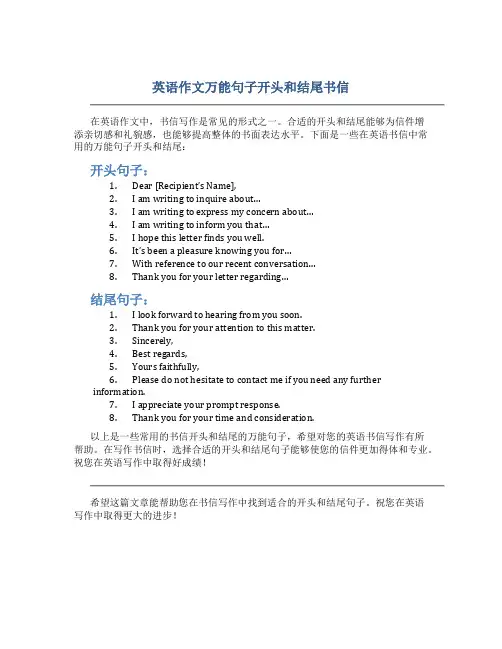
英语作文万能句子开头和结尾书信在英语作文中,书信写作是常见的形式之一。
合适的开头和结尾能够为信件增添亲切感和礼貌感,也能够提高整体的书面表达水平。
下面是一些在英语书信中常用的万能句子开头和结尾:开头句子:1.Dear [Recipient’s Name],2.I am writing to inquire about…3.I am writing to express my concern about…4.I am writing to inform you that…5.I hope this letter finds you well.6.It’s been a pleasure knowing you for…7.With reference to our recent conversation…8.Thank you for your letter regarding…结尾句子:1.I look forward to hearing from you soon.2.Thank you for your attention to this matter.3.Sincerely,4.Best regards,5.Yours faithfully,6.Please do not hesitate to contact me if you need any furtherinformation.7.I appreciate your prompt response.8.Thank you for your time and consideration.以上是一些常用的书信开头和结尾的万能句子,希望对您的英语书信写作有所帮助。
在写作书信时,选择合适的开头和结尾句子能够使您的信件更加得体和专业。
祝您在英语写作中取得好成绩!希望这篇文章能帮助您在书信写作中找到适合的开头和结尾句子。
祝您在英语写作中取得更大的进步!。
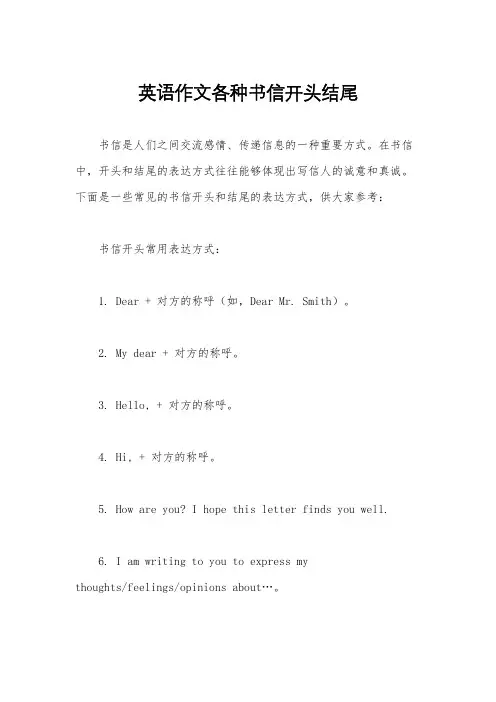
英语作文各种书信开头结尾书信是人们之间交流感情、传递信息的一种重要方式。
在书信中,开头和结尾的表达方式往往能够体现出写信人的诚意和真诚。
下面是一些常见的书信开头和结尾的表达方式,供大家参考:书信开头常用表达方式:1. Dear + 对方的称呼(如,Dear Mr. Smith)。
2. My dear + 对方的称呼。
3. Hello, + 对方的称呼。
4. Hi, + 对方的称呼。
5. How are you? I hope this letter finds you well.6. I am writing to you to express mythoughts/feelings/opinions about…。
7. I am writing in connection with…。
8. I am writing to inform you that…。
9. I am writing to request informat ion about…。
10. I am writing to apply for…。
书信结尾常用表达方式:1. Yours sincerely, + 你的名字。
2. Yours faithfully, + 你的名字。
3. Best regards, + 你的名字。
4. With best wishes, + 你的名字。
5. Looking forward to hearing from you soon.6. I hope to hear from you soon.7. Please let me know as soon as possible.8. Thank you for your attention to this matter.9. Thank you for your time and consideration.10. I am looking forward to your positive response.仿写范文:Dear Mr. Johnson,。
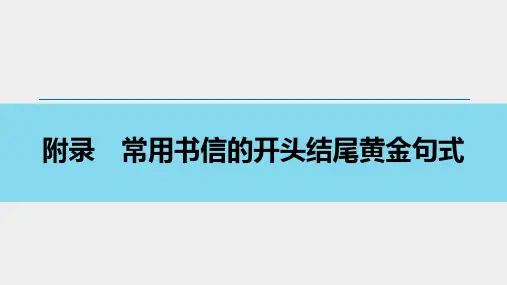
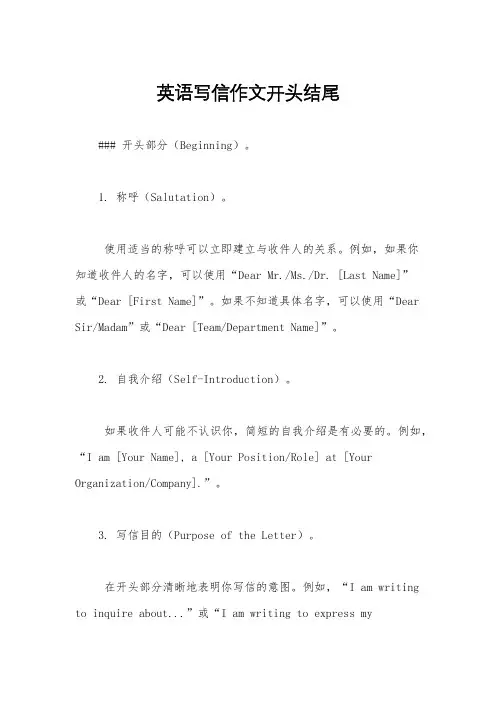
英语写信作文开头结尾
### 开头部分(Beginning)。
1. 称呼(Salutation)。
使用适当的称呼可以立即建立与收件人的关系。
例如,如果你
知道收件人的名字,可以使用“Dear Mr./Ms./Dr. [Last Name]”
或“Dear [First Name]”。
如果不知道具体名字,可以使用“Dear Sir/Madam”或“Dear [Team/Department Name]”。
2. 自我介绍(Self-Introduction)。
如果收件人可能不认识你,简短的自我介绍是有必要的。
例如,“I am [Your Name], a [Your Position/Role] at [Your Organization/Company].”。
3. 写信目的(Purpose of the Letter)。
在开头部分清晰地表明你写信的意图。
例如,“I am writing to inquire about...”或“I am writing to express my
gratitude for...”。
示例开头:
Dear Mr. Smith,。
I hope this letter finds you well. I am John Doe, a sales representative at ABC Company. I am writing to discuss the possibility of establishing a。
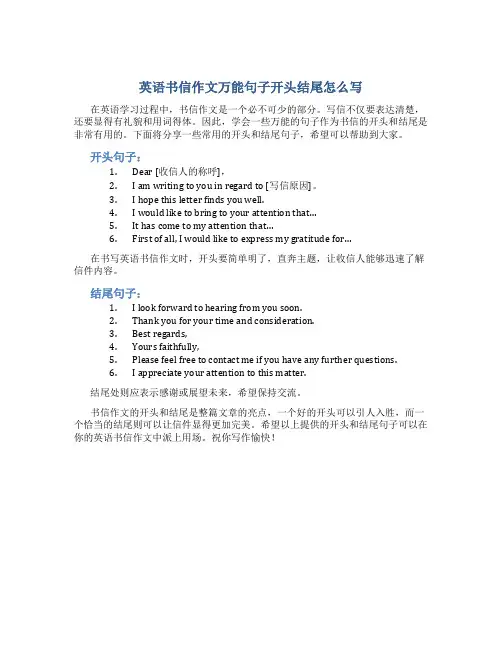
英语书信作文万能句子开头结尾怎么写在英语学习过程中,书信作文是一个必不可少的部分。
写信不仅要表达清楚,还要显得有礼貌和用词得体。
因此,学会一些万能的句子作为书信的开头和结尾是非常有用的。
下面将分享一些常用的开头和结尾句子,希望可以帮助到大家。
开头句子:1.Dear [收信人的称呼],2.I am writing to you in regard to [写信原因]。
3.I hope this letter finds you well.4.I would like to bring to your attention that…5.It has come to my attention that…6.First of all, I would like to express my gratitude for…在书写英语书信作文时,开头要简单明了,直奔主题,让收信人能够迅速了解信件内容。
结尾句子:1.I look forward to hearing from you soon.2.Thank you for your time and consideration.3.Best regards,4.Yours faithfully,5.Please feel free to contact me if you have any further questions.6.I appreciate your attention to this matter.结尾处则应表示感谢或展望未来,希望保持交流。
书信作文的开头和结尾是整篇文章的亮点,一个好的开头可以引人入胜,而一个恰当的结尾则可以让信件显得更加完美。
希望以上提供的开头和结尾句子可以在你的英语书信作文中派上用场。
祝你写作愉快!。
英语作文万能句子开头和结尾书信
开头:
1.Dear Sir/Madam,
2.I am writing to express my concern about…
3.I am writing to inquire about…
4.I am writing to bring to your attention…
5.With reference to your advertisement in the
newspaper…
6.I am writing to apply for the position of…
结尾:
1.Thank you for your attention to this matter.
2.I look forward to hearing from you soon.
3.Yours sincerely,
4.If you require any further information, please do not
hesitate to contact me.
5.Thank you for your time and consideration.
6.Yours faithfully,
书信是交流和表达情感的一种方式。
在写英语作文时,书信部分是必不可少的一部分。
书信的开头和结尾常常能够决定整篇文章的格局和氛围。
下面就给您介绍一些常用的英语作文万能句子开头和结尾书信。
开头部分:
在书信的开头部分,一般需要表明写信的目的或是与对方的关系。
使用一些客套话语可以使整封信更加礼貌和亲切。
1.使用。
高中书信类应用文常用开头结尾句型1几种常见的信件开头句型(1)回信常见开头:I am very glad to hear from you.Thank you for your letter/e-mail.Your letter/e-mail of … has been received.It is a pleasure for me to get your letter/e-mail.I'm sorry to have taken so long to answer your last letter/e-mail.(2)求职信:I have learned from your advertisement that you need a…(某职位). I'm writing to apply for the job.(3)祝贺信:I'm writing with delight to congratulate you on…(4)征求建议信:I'm writing to ask for your advice on how to…(5)建议信:I am writing in r eply to…I would like to suggest that…I am writing to express my views concerning…You have asked me for my advice with regard to…, and I will try to make some suggestions.(6)感谢信:I'm now writing these few lines to express my sincere thanks for…I am wri ting to extend my sincere gratitude for…I am writing to express my thanks for…I am writing to show my sincere appreciation for…I would like to convey in this letter my heartfelt thanks to you for…(7)慰问信:I'm extremely sorry to hear about your illness. /I felt very sorry indeed to hear of your illness.(8)道歉信:I am terribly sorry to tell you that I…I am writing this letter to express my regret…I am writing to apologize for…I would like to give you my apology for…I am very sorry to say that…I must apologize about(not)doing sth…Please accept my sincere apology for…I am writing to say sorry for…I am terribly sorry, but…2几种常见的信件结尾句型(1)感谢信:I must thank you again for your generous help.I am most grateful for your selfless donation.I feel most obliged to thank you once more.Please accept my gratitude, now and always.(2)道歉信:Once again, I am sorry for any inconvenience caused.Please allow me to say sorry again.Hope you can accept my apologies and understand my situation.I sincerely hope that you will be able to think in my position and accept my apologies.(3)建议信:I hope you will find thesesuggestions/proposals/recommendations helpful/practical/useful.I would be more than happy to see improvements in this regard.(4)求职信:I would appreciate the privilege of an interview. I may be reached at the address given above, by telephone at…, or by e-mail at…I would be glad to have a personal interview.Thank you for your time and consideration.Thank you for your attention to this matter. I look forward to talking with you.I would welcome the opportunity for a personal interview with you at your convenience.。
英语写信格式开头结尾常用语句一、开头常用语句:1. Dear [对方姓名],如:Dear Mr. Smith,2. Hello [对方姓名],如:Hello Jane,3. Hi [对方姓名],如:Hi David,4. Dear Sir/Madam,(当对方姓名不明确时)亲爱的先生/女士,5. To whom it may concern,(当信件对象不明确时)敬启者,6. I hope this letter finds you well.(一般正式信件开头)希望您身体健康。
7. I am writing to inquire about/express my concern regarding…(正式信件请求或表达关切)8. I am writing to inform you/update you on…(正式信件通知或更新)9. I am writing to apply for the position of…(求职信开头)10. Thank you for your prompt response to my previous inquiry.(感谢对方之前的回复)二、结尾常用语句:1. Thank you for your attention to this matter.(感谢对方关注此事)2. I appreciate your prompt attention to this matter.(感谢您对此事的迅速处理)3. Please do not hesitate to contact me if you have any further questions.(如果有任何进一步的问题,请随时与我联系)4. I look forward to hearing from you soon.(期待尽快收到您的回复)5. Thank you for your cooperation.(感谢您的合作)6. Yours sincerely,(信中称呼对方为名字时)如:Yours sincerely, David Smith7. Yours faithfully,(信中称呼对方为职位、未具体名字时)如:Yours faithfully, Sales Manager8. Best regards,(比较友好的信末敬语)如:Best regards, Jane9. Sincerely yours,(感谢信或正式信末常用敬语)如:Sincerely yours, John10. Warm regards,(比较亲切的信末敬语)如:Warm regards, Anna三、格式常用语句:以下是一封常见的格式化英语信件的示范:【日期】5th February 2022【收信人地址】Mr. John Smith123 Main StreetNew York, NY 12345United States【称呼】Dear Mr. Smith,【信件正文】I hope this letter finds you well. I am writing to inquire about the availability of your products and to request a price list. I am particularly interested in the models X and Y, as mentioned on your website. Could you kindly provide me with information regarding pricing, delivery times, and any discounts you may offer for bulk orders?I would greatly appreciate your prompt attention to this matter. If you have any further questions or require additional information, please do not hesitate to contact me. I look forward to hearing from you soon.【结尾敬语】Thank you for your attention to this inquiry.Yours sincerely,David Johnson-----------------------------------------------------------希望以上内容能对您有所帮助。
在写英语书信是需要灵活运用一些万能的句子来使信件更加得体合适。
下面将会介绍各类英语书信中常见的开头结尾万能句子,使您能够更好地表达自己的意思并展示出自己的礼貌和诚意。
开头句子1.Dear [姓名],2.Hello [姓名],3.I hope this letter finds you well.4.I am writing to you regarding…5.Thank you for your letter/email.6.It was a pleasure to hear from you.7.I trust this letter finds you in good health.8.How are you doing?9.I am writing to express my gratitude for…10.Your recent letter has come to hand.结尾句子1.Yours sincerely,2.Yours faithfully,3.Yours truly,4.Best regards,5.With kind regards,6.With warm regards,7.I look forward to hearing from you soon.8.I hope to hear from you soon.9.Thank you for your consideration.10.Please do not hesitate to contact me if you need any furtherinformation.以上是写英语书信时常用的开头和结尾句子,希望对您在书写书信时有所帮助。
祝您在交流中能够流畅表达自己的意思,展现出您的礼貌和真诚。
英语写信作文通用开头结尾写信是我们在生活中常常需要应用的一种技能,无论是写给朋友、家人还是老师,一封好的信件开头结尾都能让对方感到亲切和受到尊重。
接下来我们来探讨一下英语写信作文通用的开头和结尾。
开头在写信的开头部分,我们需要先表达自己写信的目的或者缘由。
通常,我们可以用以下几种方式来开头一封信:1.致以问候:Dear + 对方称呼。
如:Dear Mr. Smith,2.引出话题:I hope this letter finds you well.3.表达感谢:I am writing to express my gratitude for…以上是常用的三种开头方式,根据不同的情况选择合适的开头,能让信件更有针对性和亲近感。
结尾在写信的结尾部分,我们需要恰当地结束信件并表达对对方的祝禿或者感谢。
以下是一些常用的结尾方式:1.表达祝福:I wish you all the best.2.感谢对方:Thank you for taking the time to read my letter.3.邀请交流:I look forward to hearing from you soon.为了给信件一个完整的结束,我们可以选择以上任意一种或者根据信件的内容自行拟定一个合适的结尾。
确保结尾的语气亲切和真诚,给对方留下良好的印象。
通过适当的开头和结尾,我们可以让一封信件显得更加真诚和有吸引力,使对方更愿意倾听我们的心声。
在日常生活中多多练习写信,培养良好的写作习惯,将有助于提升我们的交际能力和表达能力。
希望以上内容能对你写英语信件有所帮助。
英语作文书信万能句子开头和结尾
一、开头句子:
•谢谢您给予我这次写信的机会。
•我写信给你是因为……
•信中我想谈谈……
•我希望您能够……
•随着现代社会的快速发展,……
•经过深思熟虑,我决定给您写信。
•我意识到……
•请允许我为您写这封信。
•在这封信中,我想探讨……
•我深信……
•非常荣幸向您呈上这封信。
•我很高兴有机会给您写信。
•近期我考虑了一件事,因此给您写信。
•睡前我的心情很激动,所以我决定写信给您。
•愿这封信能传递我的真诚与喜悦。
二、结尾句子:
•期待您的答复。
•请您留意我的请求。
•请您相信我的真诚。
•感谢您抽出宝贵的时间阅读这封信。
•请您考虑我的建议。
•我会等待您的回信。
•请您务必在此事上支持我。
•随信附上我的真诚谢意。
•请您尽快答复,我将非常感激。
•感谢您的关注与支持。
•请接受我最诚挚的问候。
•我对您的回信深感期待。
•愿我的诚挚之意感动您。
•此致敬礼,期待与您的再次联系。
•愿您所有的愿望都能实现。
•请您放心,我会谨慎对待您的来信。
•请不要忘记我的请求,谢谢。
以上句子仅供参考,您可以根据实际情况适当修改。
祝您写作愉快!。
写作开头结尾常用表达方式
1. 一般开头
How is everything going with you? I am writing to extend my heart-felt thanks to you for …(感谢)
Thank you for your letter of February 8 informing me that I have been accepted by your college. But I must apologize to you for… (道歉)
I am writing to inform you that ... (通知)
I am writing to seek your assi stance in… to request to(请求)
I am writing to express my views on … (建议)
I am writing in response to your… (回应)
I am writing to apply for the scholarship that your department offers to students from other countries. (申请)
I am writing to see if it is possible for you to provide me with information regarding…(咨询)
I am writing to express my disappointment/dissatisfaction about … to complain about …(抱怨)
I am writing to lodge a claim for the suitcase I lost on my journey to … (挂失)
I have learned from…that you are looking for …. And I am writing to recommend …for the post.(推荐)
补充句型:I am writing this letter for the purpose of doing sth. (较为正式)
2. 表达感谢的句型
I am most grateful to you for your…
I am writing this letter to express my sincere gratitude for…
I would like to convey in this letter my heartfelt thanks for…
I feel greatly indebted to you for ….
I am writing to tell you how greatly I appreciate all you have done for me.
But for your kind assistance, I would have …
I must thank you again for your generous help.
My thanks to you for you generous help are beyond words.
Please accept my deepest gratitude.
3. 表达道歉的句型
I feel really sorry to you for …
I must apologize to you for…
I would like to express my deepest apology/regret for not being able to …
Had I …, I would have…
I want you to know how badly I feel about…
4. 一般结尾
Any favorable consideration on my application/requests will be highly appreciated.
I am looking forward to your favorable reply at your earliest convenience.。